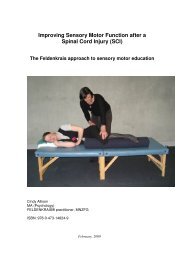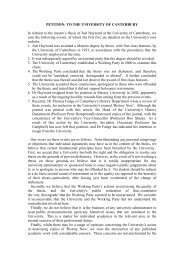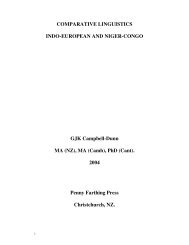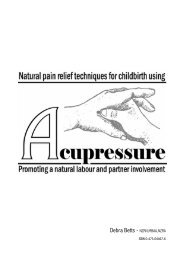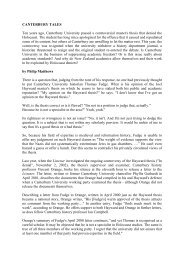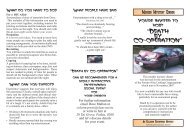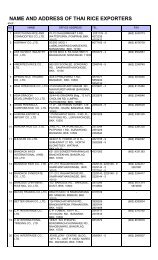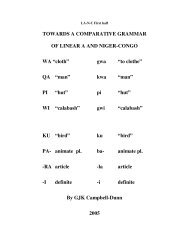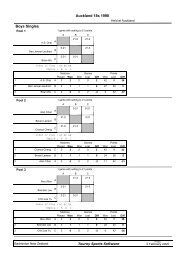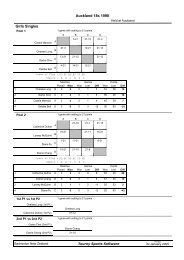Wairua and the relationship it has with learning te reo ... - Clear Net
Wairua and the relationship it has with learning te reo ... - Clear Net
Wairua and the relationship it has with learning te reo ... - Clear Net
You also want an ePaper? Increase the reach of your titles
YUMPU automatically turns print PDFs into web optimized ePapers that Google loves.
Discussion, <strong>Wairua</strong> <strong>and</strong> Learning:<br />
The symbolism of <strong>the</strong> quin<strong>te</strong>ssential nature of <strong>the</strong> Whare Tipuna 15 is<br />
being used to support this discussion on wairua <strong>and</strong> <strong>learning</strong> <strong>te</strong> <strong>reo</strong> Māori.<br />
Te Teko<strong>te</strong>ko o <strong>te</strong> Whare nei:<br />
<strong>Wairua</strong> w<strong>it</strong>hin Te Ataarangi is according to <strong>the</strong> participants in<strong>te</strong>rviewed,<br />
manifes<strong>te</strong>d in two distinct ways. The wairua of <strong>the</strong> <strong>reo</strong> <strong>it</strong>self was<br />
experienced <strong>and</strong> secondly <strong>the</strong> wairua w<strong>it</strong>nessed <strong>and</strong> experienced w<strong>it</strong>hin<br />
<strong>the</strong> process of language acquis<strong>it</strong>ion was identified.<br />
“Te <strong>reo</strong> Māori as I see <strong>it</strong> is a <strong>reo</strong> wairua, a spir<strong>it</strong>ual language”<br />
(Rangihau 2004:1A,047)(Milroy 2005)(Pere 2004).<br />
The <strong>reo</strong> <strong>it</strong>self is an ancient spir<strong>it</strong>ual language (Rangihau 2004:1A,060-067)<br />
<strong>and</strong> can be ‘heard’ on many levels depending upon <strong>the</strong> lis<strong>te</strong>ner, <strong>it</strong>s<br />
essence is felt through <strong>the</strong> energy of <strong>it</strong>’s vibrations. Ihirangaranga, <strong>the</strong><br />
weaving of spir<strong>it</strong>ual power, is one of <strong>the</strong> words used to describe vibrations<br />
felt in waiata, “I can feel that on my neck, i roto i <strong>te</strong> waiata” (Hunkin<br />
2004:2A,242). People w<strong>it</strong>h that x factor in <strong>the</strong>ir voice have that abil<strong>it</strong>y, to<br />
sing in an ihirangaranga mode <strong>and</strong> weave spir<strong>it</strong>ual power into <strong>the</strong><br />
environment <strong>the</strong>y are in, <strong>it</strong>’s as if <strong>the</strong> <strong>reo</strong> is a vehicle or ‘conductor’ of <strong>the</strong><br />
wairua, <strong>and</strong> <strong>the</strong> singer <strong>the</strong> catalyst (Rangihau 2004:6B,011-073). This<br />
phenomenon is not felt through all waiata <strong>and</strong> you can only feel <strong>the</strong><br />
ihirangaranga through some people (Hunkin 2005)(Pere 2004). Riako <strong>and</strong><br />
ngao 16 describe energy that can also be felt as vibrations w<strong>it</strong>hin waiata<br />
(Hunkin 2005)(Hunkin 2004:2A,250-297). W<strong>it</strong>hin <strong>the</strong> word riako is <strong>the</strong> word<br />
ako meaning <strong>te</strong>ach or learn implying wairua <strong>has</strong> a role to play w<strong>it</strong>hin this<br />
field (Pere 2005). Riako in waiata “sends <strong>it</strong> home, meanings come home to<br />
you” (Hunkin 2004:2A,270). Waiata play “a really important part in<br />
15<br />
The symbolism of <strong>the</strong> Whare Tipuna was adap<strong>te</strong>d from Durie’s model of Te Tapa Wha.<br />
Durie M. (1998) “Whaiora: Māori Health Development” (2<br />
27<br />
nd Ed) Auckl<strong>and</strong>, Oxford Univers<strong>it</strong>y<br />
Press. pp 69.<br />
16<br />
Ngao, described in course wr<strong>it</strong>ings as <strong>the</strong> energy w<strong>it</strong>hin <strong>the</strong> world that in<strong>te</strong>racts w<strong>it</strong>h<br />
particles, <strong>the</strong> konehunehu, is similar to explanations of physical real<strong>it</strong>y found in Quantum<br />
Physics. Te Ataarangi (2003b) “Kia Ora ai <strong>te</strong> Tinana” Hamilton, Te Ataarangi, pp 18,19.<br />
Te Ataarangi (2004a) “Kia Ora ai <strong>te</strong> <strong>Wairua</strong>” Hamilton, Te Ataarangi, pp 16.



